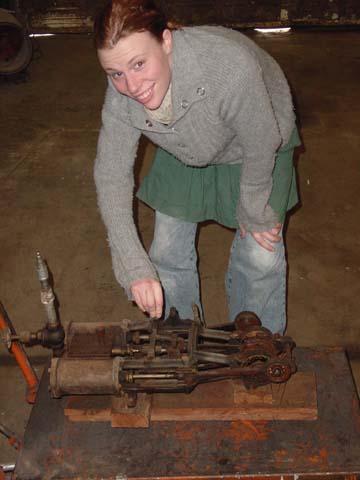Double-barreled Steam PowerZane finds a gemMarch 12: One of Windward's long-term goals is to use solar-powered steam to generate the electricity we use, and to provide heat for the greenhouses that will keep our fish and tomatoes warm in winter. And while steam engines aren't new, they're not trivial either since steam at 150 psi is also at 360° F. (and effectively much hotter than that because of the latent heat steam carries) which is why we're doing our initial work with compressed air--since we know we're going to make mistakes along the way, we want them to go "pop" rather than BANG!.
Once we get the axial flux alternator built and installed on the steam engine, and once the control computer has all the bugs shaken out, we'll take the last step of setting up the horizontal parabolic collectors to generate the steam. Between the PV panels we have feeding the grid, and our baby one horsepower steam engine, we'll be generating a kilowatt of electricity. That's enough to allow us to hone our system to the point where it's reliable, but to go beyond that, we'll need a bigger steam engine. Mike Brown Steam Engines builds and sells the 1 HP steam engine we have for $1,200, and a two-cylinder version for $2,400.
At that point, we're going to want to start making our own steam engines, and while we could just copy the little 1 HP engine, it would be more efficient to build one that's twice as large, and use the two in tandem. The amount of heat absorbed by a trough collector depends on the time of day; for example, from say 8 to 9 am, it would be collecting enough heat to power the 1 HP engine. Then, say from 9 to 10:30 am, it would generate enough heat to power the double engine, and from 10:30 to 1:30--when the sun is more directly over the trough--both engines would be running producing 3 kilowatts of electricity and 9 kilowatts of "waste" heat for the greenhouse, fish tanks, hot tub, etc. Windward's focus has always been on becoming more self-reliant rather than trying to become self-sufficient, recognizing that having strong ties to our community is a key part of sustainability. Zane owns the largest machine shop in our county, and he's been a long-term friend and collaborator on our renewable energy projects. When Jay and I stopped in to machine a bushing for the "Bat" compressor (more on that in a soon-to-come article), he presented us with a twin-cylinder steam engine that he'd found in a farmer's scrap pile. After a liberal application of penetrating oil, he had been able to get it running on compressed air. What a delight it is to see a piece of history come back to life!
One of the advantages of a steam engine over an internal combustion engine is that it's capable of developing full power from a dead stop, with the result that steam engines don't need a clutch. That's not entirely true with a single piston steam engine since they are reciprocating engines and can get stuck at top-dead-center, but the double piston engines are designed so that at least one cylinder is engaged at all times.
With a working engine to copy, we'll be able to take it apart and use the pieces to make patterns. Once we have a set of patterns, the next step is to melt down cast iron engine blocks from junk cars and pour the castings needed to make more steam engines. One fun aspect of foundry work is that there's not much more effort needed to make ten of something than there is to make one since the tedious part is the set up--doing the casting is actually the fun part. Of all the various crafts I've tried my hand at, there's nothing I've found that compares with being able to pour molten metal into a mold and create new things from scrap. March 13: Dan, one of the brains behind Otherpower.com, had no problem identifying our newly acquired mystery engine as being from a 1899 Stanley Steamer automobile. And so, instead of having just a really great way to generate power, we also now have a really, really cool way to power up a small vehicle to run on biomass! For a pic of what the engine looks like when it's clean and ready to install. Click Here. And for an excellent discussion of the history of the Stanley Steamer, Click Here. |



